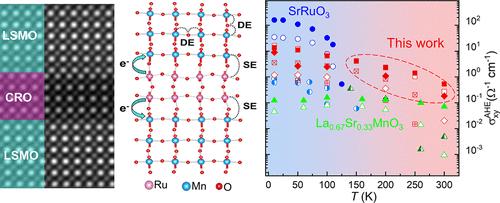Our official English website, www.x-mol.net, welcomes your
feedback! (Note: you will need to create a separate account there.)
Room-Temperature Ferromagnetism with Strong Spin–Orbit Coupling Achieved in CaRuO3 Interfacial Phase via Magnetic Proximity Effect
ACS Nano ( IF 15.8 ) Pub Date : 2024-11-11 , DOI: 10.1021/acsnano.4c10014 Jie Zheng, Jing Zhang, Sheng Cheng, Wenxiao Shi, Mengqin Wang, Zhe Li, Yunzhong Chen, Fengxia Hu, Baogen Shen, Yuansha Chen, Tao Zhu, Jirong Sun
ACS Nano ( IF 15.8 ) Pub Date : 2024-11-11 , DOI: 10.1021/acsnano.4c10014 Jie Zheng, Jing Zhang, Sheng Cheng, Wenxiao Shi, Mengqin Wang, Zhe Li, Yunzhong Chen, Fengxia Hu, Baogen Shen, Yuansha Chen, Tao Zhu, Jirong Sun

|
Recently, theoretical and experimental research predicted that ferromagnets with strong spin–orbit coupling (SOC) could serve as spin sources with dramatically enhanced spin–orbit torque (SOT) efficiency due to the combination of spin Hall effect and anomalous Hall effect (AHE), presenting potential advantages over conventional nonmagnetic heavy metals. However, materials with a strong SOC and room-temperature ferromagnetism are rare. Here, we report on a ferromagnetic (FM) interfacial phase with Curie temperature exceeding 300 K in the heavy transition-metal oxide CaRuO3, in proximity to La0.67Sr0.33MnO3. Electron energy loss and polarized neutron reflectometry spectra reveal the strong charge transfer from Ru to Mn at the interface, triggering antiferromagnetic exchange interactions between interfacial Ru/Mn ions and thus transferring magnetic order from La0.67Sr0.33MnO3 to CaRuO3. An obvious advantage of such interfacial phase is the enhanced anomalous Hall effect at temperatures from 150 to 300 K. Compared to the most promising room-temperature ferromagnetic oxide La0.67Sr0.33MnO3, the anomalous Hall conductivity σxyAHE (or anomalous Hall angle θH) of CaRuO3/La0.67Sr0.33MnO3 superlattices is increased by 30 (or 31) times at 150 K and 10 (or 3) times at 300 K. This work demonstrates a special approach for inducing ferromagnetism in heavy transition-metal oxides with strong SOC, offering promising prospects for all-oxide-based spintronic applications.
中文翻译:

通过磁邻近效应在 CaRuO3 界面相中实现具有强自旋-轨道耦合的室温铁磁性
最近,理论和实验研究预测,由于自旋霍尔效应和反常霍尔效应 (AHE) 的结合,具有强自旋轨道耦合 (SOC) 的铁磁体可以用作自旋源,具有显着提高的自旋轨道扭矩 (SOT) 效率,与传统非磁性重金属相比具有潜在优势。然而,具有强 SOC 和室温铁磁性的材料很少见。在这里,我们报告了重过渡金属氧化物 CaRuO3 中居里温度超过 300 K 的铁磁 (FM) 界面相,接近 La0.67Sr0.33MnO3。电子能量损失和极化中子反射光谱揭示了界面处从 Ru 到 Mn 的强电荷转移,触发界面 Ru/Mn 离子之间的反铁磁交换相互作用,从而将磁序从 La0.67Sr0.33MnO3 转移到 CaRuO3。这种界面相的一个明显优势是在 150 至 300 K 的温度下增强了异常霍尔效应。与最有前途的室温铁磁氧化物 La0.67Sr0.33MnO3 相比,CaRuO3/La0.67Sr0.33MnO3 的异常霍尔电导率σxyAHE(或异常霍尔角 θH)超晶格在 150 K 时增加 30 倍(或 31 倍),在 300 K 时增加 10 倍(或 3 倍)。这项工作展示了一种在具有强 SOC 的重过渡金属氧化物中诱导铁磁性的特殊方法,为全氧化物基自旋电子学应用提供了广阔的前景。
更新日期:2024-11-11
中文翻译:

通过磁邻近效应在 CaRuO3 界面相中实现具有强自旋-轨道耦合的室温铁磁性
最近,理论和实验研究预测,由于自旋霍尔效应和反常霍尔效应 (AHE) 的结合,具有强自旋轨道耦合 (SOC) 的铁磁体可以用作自旋源,具有显着提高的自旋轨道扭矩 (SOT) 效率,与传统非磁性重金属相比具有潜在优势。然而,具有强 SOC 和室温铁磁性的材料很少见。在这里,我们报告了重过渡金属氧化物 CaRuO3 中居里温度超过 300 K 的铁磁 (FM) 界面相,接近 La0.67Sr0.33MnO3。电子能量损失和极化中子反射光谱揭示了界面处从 Ru 到 Mn 的强电荷转移,触发界面 Ru/Mn 离子之间的反铁磁交换相互作用,从而将磁序从 La0.67Sr0.33MnO3 转移到 CaRuO3。这种界面相的一个明显优势是在 150 至 300 K 的温度下增强了异常霍尔效应。与最有前途的室温铁磁氧化物 La0.67Sr0.33MnO3 相比,CaRuO3/La0.67Sr0.33MnO3 的异常霍尔电导率σxyAHE(或异常霍尔角 θH)超晶格在 150 K 时增加 30 倍(或 31 倍),在 300 K 时增加 10 倍(或 3 倍)。这项工作展示了一种在具有强 SOC 的重过渡金属氧化物中诱导铁磁性的特殊方法,为全氧化物基自旋电子学应用提供了广阔的前景。

































 京公网安备 11010802027423号
京公网安备 11010802027423号